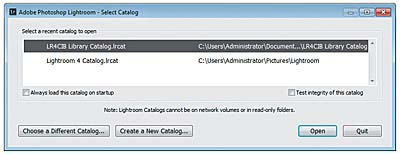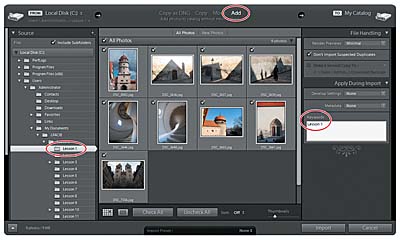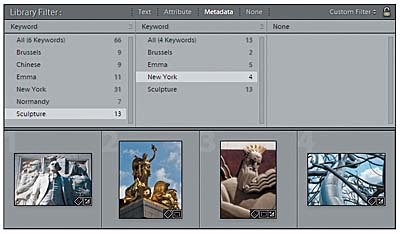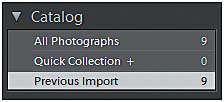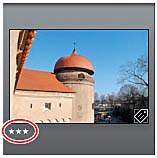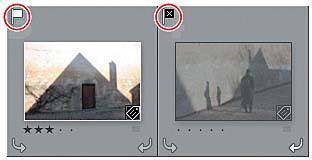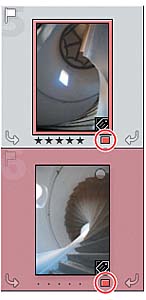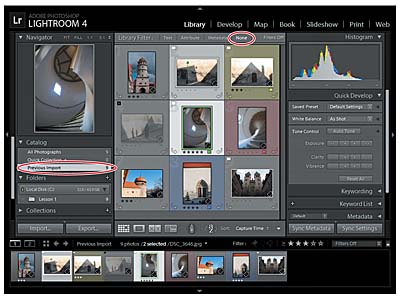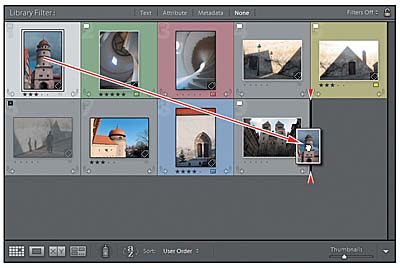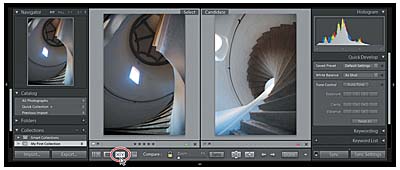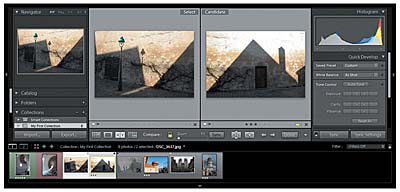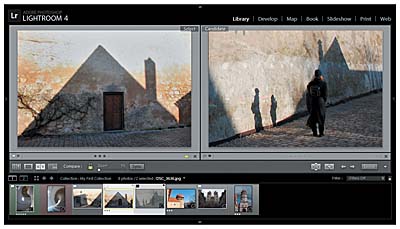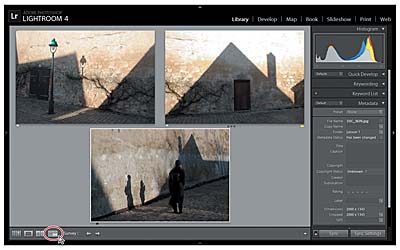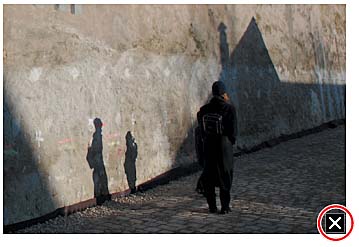The Lightroom workflow
The modular Lightroom interface makes it easy to manage every stage of your workflow, from image acquisition to finished output:
- Import The Lightroom workflow begins in the Library module, where you can choose to acquire images from your hard disk or external storage media, or from your camera. You can import photos from another application, grab still frames from video—even bypass your camera’s memory card and capture photos directly into Lightroom.
- Organize You can set the options in the Import dialog box to apply a basic level of organization to your catalog by adding keyword tags and other metadata to your photos in batches. Once the photos have been imported, you’ll use the Library and Map modules to manage them—to tag, sort, and search your image library by location, keywords, flags, and ratings, and to create collections to group your photos by any association you wish.
- Process You’ll crop, adjust, correct, retouch, and apply effects to your images in the Develop module. Optionally, you can launch an external image editor from within Lightroom for additional pixel-based editing.
- Create In the Book, Slideshow, Print and Web modules, you can put together polished presentations and layouts to showcase your photos.
- Output Some output operations—such as exporting your edited images in a variety of digital file formats or sharing them as e-mail attachments—are not tied to any specific module and are always accessible via menu commands. The Book, Slideshow, Print and Web modules each have their own output options and export controls. The Library module hosts the Publish Services panel for sharing your images online.
In the exercises to follow, you’ll step through a typical workflow as you familiarize yourself with the Lightroom workspace.
Importing photos
You can import photos into your Lightroom library from your hard disk, your camera, a memory card reader, or from external storage media. During the import process you can choose from many options to help you manage and organize your files. For the purposes of this Quick Tour we will ignore most of these advanced options; Lesson 3, “Importing,” will go into more detail.
Before you start on the exercises in this section, make sure that you have correctly copied the Lessons folder from the CD in the back of this book onto your computer’s hard disk as detailed in “Copying the Classroom in a Book files” on page 2, and created the LR4CIB Library Catalog file to manage the lesson files as described in “Creating a catalog file for working with this book” on page 3.
- Start Lightroom. In the Adobe Photoshop Lightroom - Select Catalog dialog box, make sure that the file LR4CIB Library Catalog.lrcat is selected in the Select A Recent Catalog To Open list, and then click Open.
- Lightroom will open in the screen mode and workspace module that were active when you last quit. If necessary, switch to the Library module by clicking Library in the Module Picker at the top of the workspace.
- Choose File > Import Photos And Video. If the Import dialog box appears in compact mode, as shown in the illustration below, click the Show More Options button at the lower left of the dialog box to access all of the options available in the expanded Import dialog box.
- In the Source panel at the left of the expanded Import dialog box, navigate to the Lessons folder that you copied into the LR4CIB folder on your hard disk.
- Select the Lesson 1 folder. Ensure that all of the images in the Lesson 1 folder are checked for import.
- In the import options just above the thumbnail previews, select Add so that the imported photos will be added to your catalog without being moved or copied.
- In the File Handling panel at the right of the expanded Import dialog box, choose Minimal from the Render Previews menu and ensure that the Don’t Import Suspected Duplicates option is activated.
- In the Apply During Import panel, choose None from both the Develop Settings menu and the Metadata menu, and then type Lesson 1 in the Keywords text box. Make sure that your import is set up as shown in the illustration below, and then click Import.
The layout of the header bar of the Import screen reflects the steps in the import process: first specify the source location of the files you wish to import, select the appropriate type of import, and then choose from destination (for Copy and Move imports) and batch processing options.
Thumbnails of the Lesson 1 images appear in the Grid view of the Library module and also in the Filmstrip at the bottom of the Lightroom workspace. If you don’t see the Filmstrip, press the F6 key or choose Window > Panels > Show Filmstrip.
Reviewing and organizing
When you’re working with a library that contains many images, you need to be able to find exactly what you’re looking for quickly. Lightroom delivers numerous tools that will make organizing and finding your files easy and enjoyable.
You should make it a working habit to go through a few cycles of reviewing and organizing your files each time you import a new batch. Investing a little time in this way can save you a lot of effort later, making it much quicker and easier to retrieve the photos you want when you need to work with them.
You’ve already taken the first step towards structuring your catalog by applying the keyword tag “Lesson 1” to the lesson images as they were imported.
Tagging photos with keywords is perhaps the most intuitive and versatile way to organize your catalog, because it lets you sort and search your library based on whatever words you choose to associate with your images, making it easy to find the files you need, regardless of how they are named or where they are located.
Working in slideshow mode
As a convenient way to review the images you’ve just imported, you can now sit back and enjoy an impromptu slideshow:
- Check the Catalog panel (below the Navigator preview in the left panel group) to make sure that the Grid view is displaying the images from the previous import. Choose Window > Impromptu Slideshow or press Ctrl+Enter / Command+Return to launch a full-screen slideshow. Press the spacebar to pause and resume playback. Press the left arrow key to return to the previous image or the right arrow key to advance to the next.
- To quickly assign a rating to the image currently displayed in your slideshow, press a number between 1 (for 1 star) and 5 (for 5 stars) on your keyboard. To remove the rating, press 0. You can attach only one rating to each photo; assigning a new rating will replace the old one. For the purposes of this exercise, mark three or four images with 3, 4, and 5 stars.
- Press
the P key on your keyboard
to flag the image currently
displayed in your slideshow
as a pick (
 ),
press the X key to flag it
as a reject (
),
press the X key to flag it
as a reject ( ),
or press the U key to remove
any flags. Flag several of
the Lesson 1 images as picks,
and mark at least one as a
reject.
),
or press the U key to remove
any flags. Flag several of
the Lesson 1 images as picks,
and mark at least one as a
reject. - 4. To assign a color label to the image currently displayed in your slideshow, use the number keys. Press 6 on your keyboard to assign a red color label, press 7 for yellow, 8 for green, or 9 for blue. There’s no keyboard shortcut to assign a purple color label. To remove a color label simply press the same number again. Assign different colored labels to several of the images, and then remove one.
- Press the Esc key to stop the slideshow and return to the Library module.
- If the Filter bar is not already visible above the work area, open it by choosing View > Show Filter Bar. Click the Attribute filter. Click the fourth star, and choose Rating Is Greater Than Or Equal To from the Rating menu. Lightroom will now display only those photos with at least a 4 star rating.
- Experiment a little with the attribute filters. Try searching different star ratings; then varied combinations of ratings, flags, and labels.
Even while the slideshow is playing, you can start organizing your catalog by using keyboard shortcuts to rank your photos with star ratings, flag images as picks or rejects, or attach color labels. This makes the impromptu slideshow a great first-pass review: you can quickly mark your images, and then use a search filter to isolate the shots you want to work with once you return to the Library.
Rating stars are displayed under the thumbnail images in all of the Library module views and in the Filmstrip, as shown in the illustration at the left.
You can choose to display flags, along with other information, in the image cells in the Library views and in the Filmstrip. Images flagged as rejects appear grayed out, while those marked as picks are indicated by a white border.
Use color labels to mark photos for specific purposes or projects. You might use a red label for images you intend to crop, green for those that need correction, or blue to identify photos you wish to use in a particular presentation. To help you remember the meaning of your labels, you can assign your own names to the colors by choosing Metadata > Color Label Set > Edit. You can create several label sets, and switch between them as needed. You could customize one set for working in the Library module and another to suit your workflow in the Develop module.
In the Library module‘s Grid View, and in the Filmstrip, a photo with a color label will be framed in that color when it’s selected, and surrounded by a tinted image cell background when it’s not, as shown in the illustration at the right.
If you prefer, you can change the view options so that color labels will appear only under the thumbnail images in the Grid view. You’ll learn about customizing view options and more about assigning ratings, flags, and color labels, using both menu commands and the controls in the Toolbar, in Lesson 5, “Organizing and Selecting.”
In the Library, you can user the Filter bar above the thumbnail grid to search your images by text or metadata content, and then refine your search by filtering for one or more of the searchable attributes—rating, flag status, label color, or file type—so that only those photos you want are displayed in the Grid view and the Filmstrip.
When you’re working with only a few images, as you are in this lesson, rating, flagging, and filtering seems unnecessary, but as your photo library grows to contain hundreds or even thousands of photos you’ll find these tools invaluable. The objective of this step in your workflow is to organize your images so that you can retrieve them easily for processing in the Develop, Slideshow, Print, and Web modules.
Creating a collection
Once you’ve reviewed and sorted your library, searched your photos by keywords or text, and filtered out unwanted images using the attributes filters, you can group the remaining photos as a collection, so that you can easily retrieve the same selection at any time without repeating your search. To group your photos in a collection you can choose between several options:
- The Quick Collection: a temporary holding collection in the Catalog panel, where you can assemble a selection of images.
- A “standard” Collection: a permanent grouping of photos that will be listed in the Collections panel.
- A Smart Collection: a selection of images automatically filtered from your library according to whatever criteria you specify.
- A Publish Collection: a selection of images intended for publishing that will be listed in the Publish Services panel. A Publish Collection will keep track of images you’ve published, enabling you to check at a glance whether the versions you’re sharing are up-to-date.
- If the star rating filter is still active in the Grid view, clear this setting by choosing Library > Filter by Rating > Reset This Filter, or simply click None in the Filter bar above the Grid view to disable all active filters.
- Ensure that Previous Import is selected in the Catalog panel; the Grid view and the Filmstrip should display all nine images.
- Choose Edit > Select All; then choose Library > New Collection. In the Create Collection dialog box, type My First Collection as the collection name. Under Placement, select Top Level. Under Collection Options, activate Include Selected Photos, disable Make New Virtual Copies, and then click Create.
When you next import images, the Previous Import folder will be updated and you’ll no longer be able to isolate this particular group of images by choosing from the entries in the Catalog panel.
In this case, you could still retrieve your selection by working with the Folders panel or searching the Lesson 1 tag, but it would not be so easy to retrieve a group of photos (such as the results of a complex search) that didn’t share a keyword or were spread across separate folders.
The solution is to create a collection, a virtual grouping that will be permanently listed in the Collections panel, so you’ll be able to call up the same set of images at any time with a single click.
Your new collection is now listed in the Collections panel. The listing includes an image count showing that the collection My First Collection contains nine photos.
Rearranging and deleting images in a collection
While you’re working with the images in the Previous Import folder or the All Photographs folder, source locations listed in the Catalog panel, the order of the photos in the Grid view and in the Filmstrip is fixed; the thumbnails are either ordered by capture time (the default) or by your choice of various other criteria from the sort menu in the Toolbar, such as file name, rating, or the order in which the photos were imported into your catalog.
If the image source is a single folder without subfolders, or a collection, however, you’re free to rearrange their order in the Grid view and the Filmstrip, and even remove them from the working view without deleting them from the catalog.
- If your new collection is not already selected in the Collections panel, click to select it now. Choose Edit > Select None.
- In the Filmstrip, Ctrl-click / Command-click to select the fifth and sixth images, featuring a spiral staircase, and drag them to the left. Drag the selected photos over the space between the first and second thumbnails in the Filmstrip and release the mouse button when the black insertion line appears.
- To deselect the two photos you just moved, click an empty area in the main work area, or choose Edit > Select None. Click to select the first thumbnail in the Grid view and drag it to the right of the last image in the collection. Release the mouse button when the vertical black insertion line appears. In the Toolbar, the Sort criteria has now changed to User Order.
- Choose Edit > Select None. Right-click / Control-click the seventh image in the Grid view and choose Remove From Collection from the context menu.

Figure 27 The selected photos snap to their new positions in the Grid view and the Filmstrip.
In the Collections panel (and in the header bar of the Filmstrip) the image count shows that My First Collection now contains only 8 images.
Although you’ve removed a photo from the collection, it hasn’t been deleted from your catalog. The Previous Import folder and the All Photographs folder in the Catalog panel still contain all nine images. A collection contains only references to the files in your catalog; deleting the reference does not affect the file in the catalog.
You can include a single image in any number of collections—each collection will then contain its own reference to the same file. If you apply a modification to a photo in a collection, the modification will be visible in each folder and collection that references the same photo. This is because Lightroom stores only one entry for each image file in its library catalog, and a record of all modifications is associated with that entry; any collection including that image links to the same catalog entry, and therefore displays the modified photo. Although the original image file itself remains untouched, its catalog entry has changed to include your modifications. For more information on collections, please refer to “Using collections to organize images” in Lesson 5.
Comparing photos side by side
Often you’ll have two or more similar photos that you’d like to compare side by side. The Library module features a Compare view for exactly this purpose.
- If
you have any images selected
in the Grid view, choose Edit > Select
None. Click the Compare View
button (
 )
in the Toolbar to switch to
the Compare view. Alternately,
choose View > Compare, or
press C on your keyboard. By
default, Lightroom selects
the first two images in the
collection for comparison.
)
in the Toolbar to switch to
the Compare view. Alternately,
choose View > Compare, or
press C on your keyboard. By
default, Lightroom selects
the first two images in the
collection for comparison. - The Select pane is active by default. In the Filmstrip, click on the third thumbnail, DSC_3637.jpg, to replace the current Select image. Press the right arrow key on your keyboard to view the next photo to the right in the Candidate pane.
- Press the Tab key on your keyboard to quickly hide the side panel groups so that your photos can be displayed at a larger size in the Compare view.
- Click
the Swap button (
 )
in the Toolbar below the Candidate
image to swap the Candidate
and Select images; then, use
the right arrow key to compare
the new Select photo with next
candidate from the collection.
)
in the Toolbar below the Candidate
image to swap the Candidate
and Select images; then, use
the right arrow key to compare
the new Select photo with next
candidate from the collection. - When you’ve made your choice, click the Done button at the right end of the Toolbar. The Select image will appear in the single-image Loupe view.
Comparing several photos
The Survey view lets you compare and select from several photos at the same time; you can narrow your selection one by one, until only the best photo remains. Even while you’re working in the Compare and Survey views, you can continue to organize your photos by using menu commands and the controls in the Toolbar to assign star ratings, flags, and color labels. If necessary, use the Content menu at the right of the Toolbar to show the controls you need.
- Choose
Edit > Select None. In the
Filmstrip, Ctrl-click / Command-click
the three photos of the shadowed
wall, and then click Survey
view (
 )
in the Toolbar. Alternatively,
choose View > Survey, or
press N on your keyboard.
)
in the Toolbar. Alternatively,
choose View > Survey, or
press N on your keyboard. - Drag any of the images to reposition it in the Survey view. The other images will be shuffled automatically to accommodate your action.
- As
you move the pointer over each
of the images, a Deselect Photo
icon (
 )
appears in the lower right
corner. Click this icon to
remove a photo from the selection
in the Survey view.
)
appears in the lower right
corner. Click this icon to
remove a photo from the selection
in the Survey view. - Continue to eliminate photos from the Survey view until you’ve narrowed your selection to a single image, and then press E on your keyboard to switch to the single-image Loupe view.
- Press Shift+Tab (twice if necessary) to show all the workspace panels. Double-click the enlarged image to return to the Grid view. Choose Edit > Select None.
The Survey view will display all the selected images; the more images you select the smaller the individual preview images in the Survey view. You can make more room for the images you’re reviewing by hiding the Filmstrip and side panel groups as necessary, though the right panel group can be useful for viewing additional information about the active photo—from a histogram graphing tonal distribution to metadata about the camera, lens, and settings that were used. The active image is indicated by a thin white border; to activate a different photo, you can either click its thumbnail in the Filmstrip or click the image directly in the work area.
As you eliminate candidates the remaining photos are progressively resized and shuffled to fill the space available in the work area. Eliminating a photo from the Survey view does not remove it from the collection.
